

The Social-Ecological Model - 2015-2020 Dietary Guidelines - health.gov. Consistent evidence shows that implementing multiple changes at various levels of the Social-Ecological Model is effective in improving eating and physical activity behaviors.

For example, strong evidence from studies with varying designs and generally consistent findings demonstrates that school policies designed to enhance the school food setting leads to improvements in the purchasing behavior of children, resulting in higher dietary quality of the food consumed during the school day. For adults, moderate evidence indicates that worksite nutrition policies can improve dietary intake, and approaches targeting dietary intake and physical activity can favorably affect weight-related outcomes. These examples demonstrate how support and active engagement from various segments of society are needed to help individuals change their eating and physical activity behaviors and achieve positive outcomes. Figure 3-1. Applying the socio-ecological model to improving fruit and vegetable intake among low-income African Americans. - PubMed - NCBI.
The Social-Ecological Model - 2015-2020 Dietary Guidelines - health.gov. The Social-Ecological Model: A Framework for Prevention. The ultimate goal is to stop violence before it begins.
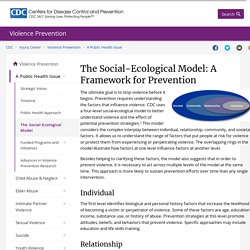
Prevention requires understanding the factors that influence violence. CDC uses a four-level social-ecological model to better understand violence and the effect of potential prevention strategies.¹ This model considers the complex interplay between individual, relationship, community, and societal factors.
It allows us to understand the range of factors that put people at risk for violence or protect them from experiencing or perpetrating violence. The overlapping rings in the model illustrate how factors at one level influence factors at another level. Besides helping to clarifying these factors, the model also suggests that in order to prevent violence, it is necessary to act across multiple levels of the model at the same time.
Individual The first level identifies biological and personal history factors that increase the likelihood of becoming a victim or perpetrator of violence. Relationship Community Societal Reference 1. C14 2011.
Equity in health care improves people's health. Promoting equity in health care improves people’s health.
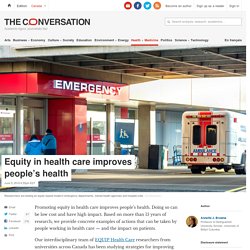
Doing so can be low cost and have high impact. Based on more than 15 years of research, we provide concrete examples of actions that can be taken by people working in health care — and the impact on patients. Our interdisciplinary team of EQUIP Health Care researchers from universities across Canada has been studying strategies for improving care. The deadly effects of social inequality. Health, Income, & Poverty: Where We Are & What Could Help. Poverty has long been recognized as a contributor to death and disease, but several recent trends have generated an increased focus on the link between income and health.

Structural Social Determinants 0. Targeted and population-based strategies both necessary for blood pressure control: Shift to team-based care can improve prevention and care for hypertension. Association of the Social Determinants of Health With Quality of Primary Care. + Author Affiliations.
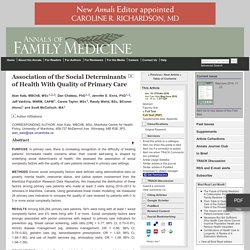
Kirchner multi level aproach. Designing and Assessing Multilevel Interventions to Improve Minority Health and Reduce Health Disparities. Investments in biomedical, social, and behavioral sciences have greatly expanded knowledge of the etiology, prevention, detection, and treatment of many diseases, and many of these advances have contributed to improved population health.
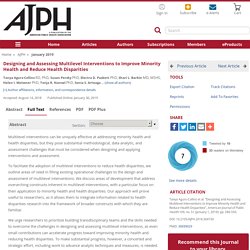
Nonetheless, not everyone has benefited equally from scientific development and medical advancement,1 and strategies to reduce socioeconomic and racial/ethnic disparities frequently remain elusive. In large part, this is because the factors that underlie disparities are wide ranging and multifaceted; these factors encompass every socioecological level, including individual, interpersonal, community, and societal (in this supplement issue, Alvidrez et al. describe the National Institute on Minority Health and Health Disparities [NIMHD] framework).2 NIMHD defines a health disparity as a health difference that adversely affects disadvantaged populations on the basis of 1 or more of the following health outcomes: Source.
Adapted from Warnecke et al.11 Note. Developing a Multilevel Approach to Improving Population Health. Heart disease is the leading cause of death for both men and women in the United States, yet heart disease is largely preventable through healthful lifestyle practices.

Effective prevention requires more than just educating people on how they can live healthier lifestyles; it’s critical for a community to support its citizens in their efforts to do so. Inspired by this, the Minneapolis Heart Institute Foundation (MHIF), Allina Health, New Ulm Medical Center (NUMC), and the rural community of New Ulm, Minnesota, teamed up to create Hearts Beat Back: The Heart of New Ulm Project (HONU). This population-based prevention demonstration project aims to reduce heart attacks and heart disease risk factors over 10 years among the New Ulm population. Multilevel Interventions To Address Health Disparities Show Promise In Improving Population Health. The Determination of Health Across the Life Course and Across Levels of Influence » SPH. In the Caribbean, colonialism and inequality mean hurricanes hit harder. Hurricane Maria, the 15th tropical depression this season, is now battering the Caribbean, just two weeks after Hurricane Irma wreaked havoc in the region.
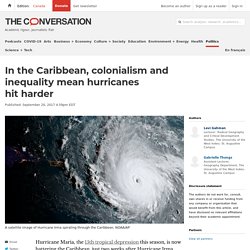
The devastation in Dominica is “mind-boggling,” wrote the country’s prime minister, Roosevelt Skerrit, on Facebook just after midnight on September 19. The next day, in Puerto Rico, NPR reported via member station WRTU in San Juan that “Most of the island is without power…or water.” Among the Caribbean islands impacted by both deadly storms are Puerto Rico, St Kitts, Tortola and Barbuda.